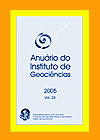Digital elevation models evaluation for geoecological studies in Pedra Branca massif, Rio de Janeiro, Brazil
DOI:
https://doi.org/10.11137/2009_1_21-33Abstract
Geoprocessing tools have been increasingly used to support the integrated study of geoecological variables, once they allow fast and efficient analysis. One of the products generated by geoprocessing of great importance do analysis that considerate the real surface of the terrain is the Digital Elevation Model (DEM). The consideration of the real surface is essential for the correct calculation of volumes, areas and distances, parameters of great importance for geomorfological indicators. There are many kinds of methods to generate this models and no consensus about which method has the best results, once it's precision will depend on characteristics of the study area. This work aims to compare the different DEM generation methods for irregular relief areas, using the Pedra Branca massif, RJ, as study area. It has been generated DEMs by two different interpolation methods and grids: one based in rectangular regular grid (TOPOGRID) and the interpolation method of Delaunay constrained, based in triangular irregular network (TIN), both generated in the software ArcGIS 9.2. For the verification of the quality and altimetric precision of these models, it has been utilized a map of declivities generated from the triangular irregular network model. Results show that the more adequate method for the study area is the TOPOGRID. However, it has been noted that this behavior is unequally distributed along its declivities classes, and it's errors are bigger in the great declivities, where the TIN model has been more efficient.Downloads
Published
2009-06-01
Issue
Section
não definida
License
This journal is licensed under a Creative Commons — Attribution 4.0 International — CC BY 4.0, which permits use, distribution and reproduction in any medium, provided the original work is properly cited.
















 Except where otherwise noted, content on this site is licensed under a license
Except where otherwise noted, content on this site is licensed under a license 